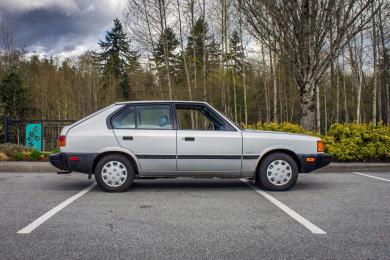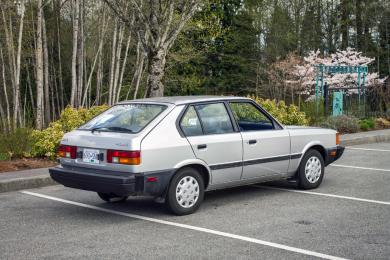Not too many folks know that Canadians were a sort of test market for Hyundai before they tried to break into the US. The Pony actually started production in Korea in the mid-1970s as Hyundai’s very first car, and it had a fairly interesting development. The underpinnings are basically a Morris Marina equipped with the rear axle out of a Ford Cortina. As mentioned, the powertrain is pretty much pure Mitsubishi, and the styling was penned by Giorgetto Giugiaro’s Italdesign. Not his finest hour, admittedly, but it’s not bad.
In Korea, you could option your Pony as a two- or four-door runabout, or even as a sort of tiny El Camino pickup-car hybrid. It was very popular, and the fledgling car company soon started thinking about the export market.
  Hyundai Pony. Click image to enlarge |
What was a pretty good car in 1974 became a paragon of mediocrity a decade later, with the addition of giant bumpers and rectangular headlights for the Canadian market. But what did you expect – this was a cheap car, not an excellent one. “Pony” is a pretty good name for a sturdy little beast like this, but they could have just as easily called it the Hyundai Adequate.
So, what’s it like to drive? In a word: slow. Slow like molasses, in January, on Pluto. Slow like a tortoise with a sports injury. Slow like a snail stuck in rush-hour traffic on the Don Valley Parkway. Slow like a sloth frozen in carbonite. Okay, I’ll stop.
But I can’t get over how thoroughly excellent this thing is. It’s in such perfect condition, and because it’s about as technologically advanced as a board with a nail in it, there’s absolutely nothing that has broken over the years. While very early cars had a few issues – notably, the doors were only engineered to open a limited number of times before the hinges gave out – the warranty was pretty good, and the dealers were supposedly very helpful.
Moving out into modern traffic, the Pony trots along at a moderate pace, its 70-hp four-banger humming away happily. What a neat car – it’s completely brute simple in its construction, and looks like it’d be very easy to keep running if you could keep the rust at bay.
It steers and accelerates (sort of), and the brakes work (sort of), and it’s actually kind of comfortable, and because this is a car from the 1980s, the tiny A-pillars mean visibility is excellent. I wouldn’t want to test out its crash durability, but there’s no reason you couldn’t drive this thing from Vancouver to Halifax if you felt like it.
Sadly, this particular Pony is not long for this land. Don’t worry, it’s not off to the glue factory; Kim plans to ship it back to his parents’ house in Korea, where his father can look after the car in his retirement. There are only five Ponys left in all of Korea, and the car has a sort of cult status over there.
And so it should. Not only is this car important as a sturdy little machine that carried the hopes of a growing automotive company to far-off shores, it’s a part of Canadian motoring history. It’s unique, and it’s special, and while it has the most modest of design intents, there’s something really likeable about it.
Even if they did sort of dissolve after a year or two of salty Canadian roads, I’m sure these memories of these little econoboxes are near and dear to the hearts of many folks. More than a few would have been somebody’s first car, got somebody to their first real job, been a steadfast and decently reliable ride that demanded very little and cost next to nothing.
Well, that’s it. I’m a fan. Call me a brony if you must, but I’ve got a soft spot in my heart for this cheerful little machine. Every dog has his day, as the old saying goes.
As it turns out, so does every Pony.











